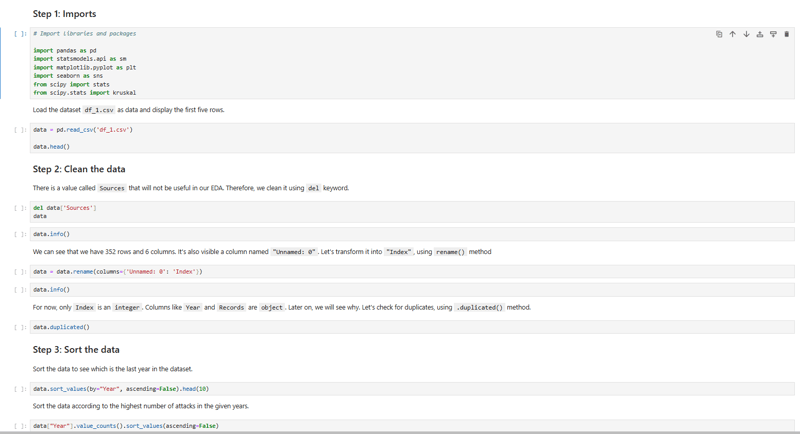Applied Data Science on data breaches + Bonus
Hello!
Today I decided to embed two domains: data science and cybersecurity.
Follow along and you'll see what I'm writing about.

What did I do?
I performed an analysis over the number of attacks based on the organization type.
I downloaded the dataset from Kaggle.
Then, I started working on the data using Jupyter Lab and Python.
The notebook is for exercises purposes, for testing and observing- or playing with- data.

As usual, the first and foremost I imported the data. Then, I loaded and cleaned the dataset.
Cleaning the data is a step that could be done more times, because EDA (Exploratory Data Analysis) is an iterative and non-sequential process. Therefore, later on I continued with this process, in order to uncover meaningful insights.
Few words about statistics
I chose a simple random sampling of n=40 to find out which organization is more prone to cyberattacks, based on the number of attacks. Simple random sampling means that every member of the population has an equal chance of being selected.
The hypothesis
Null Hypothesis (H0): There is no significant difference in the number of cyberattacks experienced by different types of organizations.
Alternative Hypothesis (H1): The number of cyberattacks differs significantly across different types of organizations.
According to the maximum number of attacks, it was concluded that healthcare industry is more prone, with 6 attacks. On the opposite, banking had the lowest number of attacks, i.e 1.
In the end, I performed a Shapiro- Wilk test, to check for the distribution normality of the dataset. The Null Hypothesis was rejected, so the data did not look normally distributed. I applied Kruskal- Wallis test, from which I failed to reject the Null Hypothesis- meaning that there is no significant difference between groups. In simpler terms, it means that there was not enough evidence to confidently say that one organization type is more prone to cyberattacks than the other.
Limitations and future considerations
No confidence level, margin of error and confidence interval were set. The sample size was small, therefore it is harder to detect statistically significant differences. In the future, the selection of a sample will respect these steps and a larger sample will be considered.
You can find the entire work on my GitHub page. ?
BONUS ?
As I specified, this article has a bonus. The combination of data science and cybersecurity goes on: I created a write-up for TryHackMe room Attacktive Directory!
One could say, at the first glance, that these topics are unrelated. Well, it's actually a demonstration of how a breach could take place! ? Because data breaches appear somehow and for some reason.
Curious? Well, check my write-up from my GitHub page.
What are your thoughts?
The above is the detailed content of Applied Data Science on data breaches + Bonus. For more information, please follow other related articles on the PHP Chinese website!

Hot AI Tools

Undresser.AI Undress
AI-powered app for creating realistic nude photos

AI Clothes Remover
Online AI tool for removing clothes from photos.

Undress AI Tool
Undress images for free

Clothoff.io
AI clothes remover

Video Face Swap
Swap faces in any video effortlessly with our completely free AI face swap tool!

Hot Article

Hot Tools

Notepad++7.3.1
Easy-to-use and free code editor

SublimeText3 Chinese version
Chinese version, very easy to use

Zend Studio 13.0.1
Powerful PHP integrated development environment

Dreamweaver CS6
Visual web development tools

SublimeText3 Mac version
God-level code editing software (SublimeText3)

Hot Topics
 1658
1658
 14
14
 1415
1415
 52
52
 1309
1309
 25
25
 1257
1257
 29
29
 1231
1231
 24
24
 Python vs. C : Applications and Use Cases Compared
Apr 12, 2025 am 12:01 AM
Python vs. C : Applications and Use Cases Compared
Apr 12, 2025 am 12:01 AM
Python is suitable for data science, web development and automation tasks, while C is suitable for system programming, game development and embedded systems. Python is known for its simplicity and powerful ecosystem, while C is known for its high performance and underlying control capabilities.
 The 2-Hour Python Plan: A Realistic Approach
Apr 11, 2025 am 12:04 AM
The 2-Hour Python Plan: A Realistic Approach
Apr 11, 2025 am 12:04 AM
You can learn basic programming concepts and skills of Python within 2 hours. 1. Learn variables and data types, 2. Master control flow (conditional statements and loops), 3. Understand the definition and use of functions, 4. Quickly get started with Python programming through simple examples and code snippets.
 Python: Games, GUIs, and More
Apr 13, 2025 am 12:14 AM
Python: Games, GUIs, and More
Apr 13, 2025 am 12:14 AM
Python excels in gaming and GUI development. 1) Game development uses Pygame, providing drawing, audio and other functions, which are suitable for creating 2D games. 2) GUI development can choose Tkinter or PyQt. Tkinter is simple and easy to use, PyQt has rich functions and is suitable for professional development.
 How Much Python Can You Learn in 2 Hours?
Apr 09, 2025 pm 04:33 PM
How Much Python Can You Learn in 2 Hours?
Apr 09, 2025 pm 04:33 PM
You can learn the basics of Python within two hours. 1. Learn variables and data types, 2. Master control structures such as if statements and loops, 3. Understand the definition and use of functions. These will help you start writing simple Python programs.
 Python vs. C : Learning Curves and Ease of Use
Apr 19, 2025 am 12:20 AM
Python vs. C : Learning Curves and Ease of Use
Apr 19, 2025 am 12:20 AM
Python is easier to learn and use, while C is more powerful but complex. 1. Python syntax is concise and suitable for beginners. Dynamic typing and automatic memory management make it easy to use, but may cause runtime errors. 2.C provides low-level control and advanced features, suitable for high-performance applications, but has a high learning threshold and requires manual memory and type safety management.
 Python and Time: Making the Most of Your Study Time
Apr 14, 2025 am 12:02 AM
Python and Time: Making the Most of Your Study Time
Apr 14, 2025 am 12:02 AM
To maximize the efficiency of learning Python in a limited time, you can use Python's datetime, time, and schedule modules. 1. The datetime module is used to record and plan learning time. 2. The time module helps to set study and rest time. 3. The schedule module automatically arranges weekly learning tasks.
 Python: Exploring Its Primary Applications
Apr 10, 2025 am 09:41 AM
Python: Exploring Its Primary Applications
Apr 10, 2025 am 09:41 AM
Python is widely used in the fields of web development, data science, machine learning, automation and scripting. 1) In web development, Django and Flask frameworks simplify the development process. 2) In the fields of data science and machine learning, NumPy, Pandas, Scikit-learn and TensorFlow libraries provide strong support. 3) In terms of automation and scripting, Python is suitable for tasks such as automated testing and system management.
 Python: Automation, Scripting, and Task Management
Apr 16, 2025 am 12:14 AM
Python: Automation, Scripting, and Task Management
Apr 16, 2025 am 12:14 AM
Python excels in automation, scripting, and task management. 1) Automation: File backup is realized through standard libraries such as os and shutil. 2) Script writing: Use the psutil library to monitor system resources. 3) Task management: Use the schedule library to schedule tasks. Python's ease of use and rich library support makes it the preferred tool in these areas.




